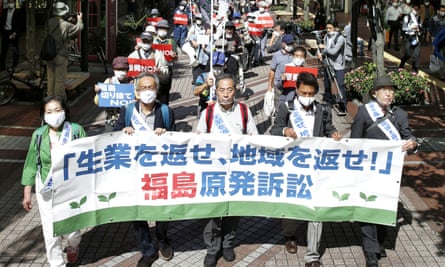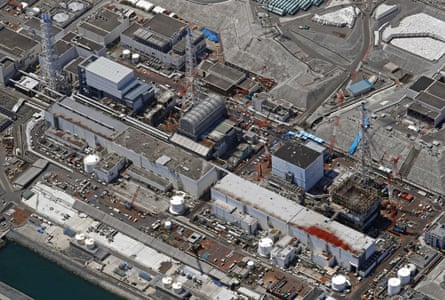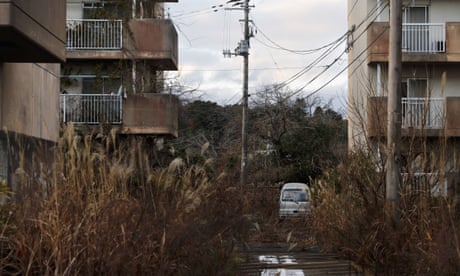
Fukushima nuclear disaster preventable, court rules, with more damages claims likely
Posted: 2nd October 2020
From the Guardian
Government and company Tepco ordered to pay some damages for 2011 event, but ruling could spur further claims

Plaintiffs and their supporters march in Japan ahead of the court ruling in Sendai on the tsunami-crippled Fukushima Daiichi nuclear power plant disaster on Wednesday. Photograph: KYODO/Reuters
A Japanese court has found the government and Tepco, the operator of the wrecked Fukushima nuclear plant, negligent for failing to take measures to prevent the 2011 nuclear disaster, and ordered them to pay 1bn yen ($9.5m) in damages to thousands of residents for their lost livelihoods.
The ruling on Wednesday by Sendai high court could open up the government to further damage claims because thousands of other residents evacuated as reactors at the coastal power station overheated and released a radioactive cloud, following the devastating tsunami. While some people have returned home, areas close to the plant are still off limits.
The plaintiffs had sought monthly compensation of about 50,000 yen ($470) per person until radiation levels subside to pre-disaster levels, seeking a total of 28bn yen ($265m).
The plaintiffs’ head lawyer, Izutaro Managi, hailed the ruling as a major victory, saying: “We ask the government to extend relief measures as soon as possible, not only for the plaintiffs but for all victims based on the damage they suffered.”
The latest ruling follows 13 lower court decisions, which were divided over government responsibility in the disaster. The latest ruling doubles the amount of damages against Tepco ordered by a lower court in 2017
In 2011, 3,550 plaintiffs were forced to flee their homes after a magnitude-9 earthquake triggered a tsunami that devastated the country’s north-east and crippled the Fukushima nuclear plant, known as the triple disaster.

Radiation that spewed from the plant’s melted reactors contaminated the surrounding areas, forcing about 160,000 residents to evacuate at one point. More than 50,000 are still displaced because of lingering safety concerns. The plant is being decommissioned, a process expected to take decades.
The court said that the government could have taken measures to protect the site, based on expert assessments available in 2002 that indicated the possibility of a tsunami of more than 15 metres, reported public broadcaster NHK, which aired footage of the plaintiffs celebrating outside the court after the ruling.
The government has yet to say whether it will appeal in the supreme court against the decision. “We will consider the ruling and take appropriate action,” chief cabinet secretary Katsunobu Kato said after the ruling.
Officials at Tepco were unavailable when Reuters tried to reach them outside regular business hours.
In court, the government argued it was impossible to predict the tsunami or prevent the subsequent disaster. Tepco said it had fulfilled its compensation responsibility under government guidelines.
Plaintiffs said the ruling brought some justice, but that their lives could never return to normal and their struggle was far from over.
“For more than nine years, I have planted seeds on the contaminated soil and grown vegetables, always worrying about the effects of radiation,” plaintiff Kazuya Tarukawa, a farmer from Sukagawa in Fukushima, said at a meeting after the ruling. “Our contaminated land will never be the same.”
